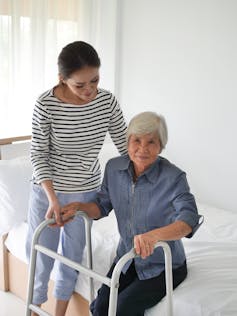COVID-19’s silver lining? Creating a caregiver-friendly work culture

About one-third of Canada’s workforce are also caregivers, most often to aging parents or parents-in-law. (Shutterstock)
BY Allison Williams
September 17, 2020
One in four Canadians provide often unseen informal care, with the majority of carers being female, over the age of 45 and caring for a parent or parent-in-law. Sixty per cent of these invisible informal carers are also juggling employment, with these carer-employees making up 35 per cent of the Canadian workforce.
COVID-19 has disproportionately affected carer-employees given the additional care load, increased carer strain and blurring of boundaries between care and work, now that many are working from home. This challenging, unique time provides a opportunity for employers to embrace a carer-friendly workplace culture.
As a health geographer, I work with a team that explores the space and time pressures that carer-employees experience daily, while juggling employment and the myriad of tasks related to their caring role — whether transport, personal care or shopping, for example. This research informs the evidence needed for employers to nurture a carer-friendly work culture.
The majority of carer-employees are female and, when compared to carer-employees who are men, they spend more hours on caring and engage in more demanding care tasks. For these reasons, and because of the gendered nature of caring, a sex- and gender-informed approach to the research provides targeted policy and practice changes.
Why employers need to support carer-employees

Juggling employment and caring negatively impacts carer-employees’ health, well-being and financial security. These negative effects show up at work, with pre-COVID statistics suggesting that 19 per cent of carer-employees experience physical and emotional health challenges, adding to employer disability claim costs. Fifteen per cent reduce their work hours, 10 per cent turn down job opportunities, and carer-employees are more likely to take leaves because of their care responsibilities.
Without effective employer supports, carer-employees are more likely to experience:
- reduced work performance;
- increased absenteeism, with some (mostly females) retiring early or quitting their jobs altogether, and;
- decreased social inclusion, which is matched with increased social isolation.
There are wins for employers who embrace a carer-friendly work culture, such as social and economic incentives, an engaged workforce, increased productivity, reduced absenteeism, reduced wasted time at work and a competitive advantage. The loss of skilled labour and increased turnover due to qualified and experienced workers leaving their employment to care for others translates into over $2 billion annually in lost productivity per year, affecting the bottom line as well.
Nurturing a carer-friendly work culture
At this opportune time, employers have a unique chance to protect the physical, emotional and financial well-being of their carer-employees through creating a carer-friendly work culture. Many employees are working from home, which is a form of flexible work and has been long identified as one of the most effective strategies for carer-employees to both provide care while remaining employed.

As long as formal health-care supports — such as personal support and nursing care — is kept intact and not withdrawn, carer-employees have the opportunity to thrive in these times. Further, this is the time for employers to step up and maximize their efforts of realizing a number of carer-friendly practices, such as the following which can be provided on-line:
- delivery of carer support groups to network
- education on the service landscape
- carer skills training (such as the use of medical devices, pharmacology)
- establishment of a carers register or passport, where care responsibilities are outlined, and carer-employees are entitled to emergency leave, as well as special leave to attend appointments, and
- more involved interventions, such as implementation of the voluntary CSA Carer-Inclusive and Accommodating Organizations Standard and accompanying handbook, which suggests compassionate training for managers, supervisors and human resources personnel.
There are specific challenges for those employed in the health-care sector, given that these carer-employees are “double-duty” carers, providing both paid work and informal care work.
Building carer-employees’ resilience and ability to cope is challenging in these demanding COVID times, particularly given that many carer-employees don’t self-identify, let alone share their carer role with their employer for fear of negative career effects or perceived stigma. Employers would do well to recognize that there is no one recipe or protocol for enhancing carer-friendliness, given the many work variables at play — such as size, sector and employee demographics. Becoming carer-friendly is a culture change process that feeds into workplace health and wellness as it addresses work-life balance and employee health.
There may be a silver lining to the pandemic: the stamping out of employer inflexibility and workplace hostility to carer-employees through the fostering a carer-friendly work culture, and the inspiration to support the sustained health, quality of life, and employment for those who care.![]()
Allison Williams is a professor of Earth, Environment & Society in the Faculty of Science. This article is republished from The Conversation under a Creative Commons license. Read the original article.


